Craving for homemade garlic mayonnaise? This Spanish garlic alioli recipe at the end of the article will have you dipping tapas and veggies nonstop!
Alioli is the go-to dipping sauce of many people. It can be enjoyed as it is, but it can also be elevated to something fancier if you like. Think truffle, wasabi, avocado…
In Spain where garlic is a prominent cooking ingredient, garlic Alioli is a staple dip not only in restaurants but in households as well. Home cooks who find joy in the process of slowly mixing olive oil to mashed garlic and egg yolk and then adding some lemon juice and salt are rewarded with something delicious!
Whether you go for the traditional mortar and pestle or opt for a food processor, the result is a creamy garlic sauce that is a true crowd-pleaser.
What is Alioli?
Is it safe to say that alioli is just a fancy word for mayonnaise with garlic?
Both alioli and mayonnaise are emulsions (more on that later…) and both serve the same purpose. Nothing differentiates the base of garlic alioli from the common mayonnaise, so we dare say yes: aioli is mayonnaise (with garlic!)
First things first, though: do you call it aioli or alioli? To answer this question, let us explore the origins of this recipe.
History of Spanish Garlic Alioli
Spanish garlic alioli comes from the Catalan sauce called allioli. The word simply means garlic (al) and oil (oli.) It was made by pounding fresh garlic and olive oil with a mortar and pestle until it forms a paste.
Sounds easy, right?
However, this traditional way of making allioli requires you to pound continuously for a good 20 minutes! It tests both your strength and patience, as you pound your way into the hopes of having a thick, rich, and creamy sauce in the end.
What is the difference between aioli and alioli?
Technically speaking, aioli pertains to the sauce made out of garlic, oil, and egg yolk originating in Provence, France. Traditionally, it was prepared the same way as allioli a la Catalana – with the labor-intensive use of mortar and pestle.
The term aioli has generally been adopted as an English term for sauces of the same ingredient and process. Therefore, when you say Spanish garlic aioli it is no different from allioli or alioli. This sauce is also called ajoaceite, ajiaceite, ajolio or ajaceite.
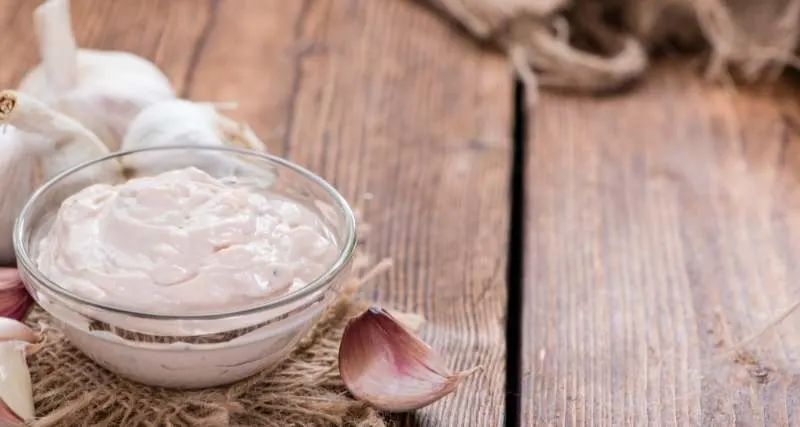
The importance of emulsification
The emulsion must occur for you to have proper homemade garlic mayonnaise. That is why any Spanish garlic alioli recipe, will tell you to be slow in adding the olive oil to the mixture.
What is really happening during this process?
Scientifically speaking, you are dispersing fat into the water so that the result would be a homogenous mixture. It’s like forcing these two immiscible liquids to combine. If you succeed in doing so, you will end up with a well-mixed sauce that is creamy and rich.
This can only be achieved if you give the base enough time to absorb the oil. An important ingredient in the mixture is what we call an emulsifier. Its role is to stabilize your sauce, and for the case of Spanish garlic alioli, the emulsifier is the egg yolk.
What are the other food items where emulsification is present? You have vinaigrette, butter, salad dressings, and pan sauces, to enumerate some.
Tips to prepare Spanish Garlic Alioli
- If you do not have a mortar and pestle at home or if you simply would like to make homemade garlic mayonnaise the easier way, you can use a handheld mixer. Place all ingredients in a bowl and steadily mix them altogether until a thick sauce forms. A food processor is another option.
- Make sure to be slow in adding the oil into the mortar. Give it time to be absorbed by the garlic and egg yolk mixture. One way to know if you have not been slow in adding the oil is when the mixture starts to look like scrambled eggs.
- One of the ways on how to test if your garlic alioli has thickened already is by scooping some with a spoon. Invert it, and if the garlic sauce did not fall, it is thick enough.
- Feel free to adjust the quantity of the lemon juice and salt according to your preference.
- Homemade Spanish garlic alioli lasts for up to four days if kept in an airtight container and refrigerated.
How to serve Spanish Garlic Alioli
Here are some of the food items that go well with Spanish garlic alioli:
- Breads and sandwiches
- Fresh vegetable sticks
- Grilled vegetables
- Spanish tapas like Gambas al Ajillo, Croquetas and Patatas Bravas
- Roast chicken
Ingredients to prepare Alioli:
- 3-4 garlic cloves
- 2/3 – 3/4 cup of olive oil
- 1 egg yolk
- Salt to taste
- 1 teaspoon of natural lemon juice
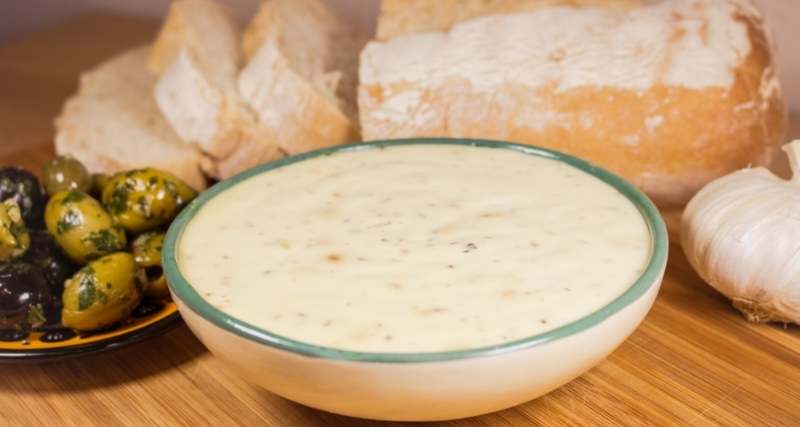
How to make garlic alioli?
1. Prepare your garlic cloves by peeling and then mincing them.
2. Transfer all of the minced garlic into the mortar. Start pounding the garlic with the use of a pestle. Mash it well.
3. In a bowl, separate the egg yolk from the egg white. Set the egg white aside for another use. Take the egg yolk, add some salt to the bowl, and stir. Pour the yolk into the mortar with the mashed garlic.
4. Take oil and add some to the mortar in a slow stream. Take your time, continuously pounding in every addition and making sure you go in one direction the whole time. Pace yourself slowly so that the mixture will blend well.
5. Check if the mixture has thickened. If yes, add in the lemon juice to create a creamy, smooth, and delicious Spanish garlic alioli.
Frequently Asked Questions
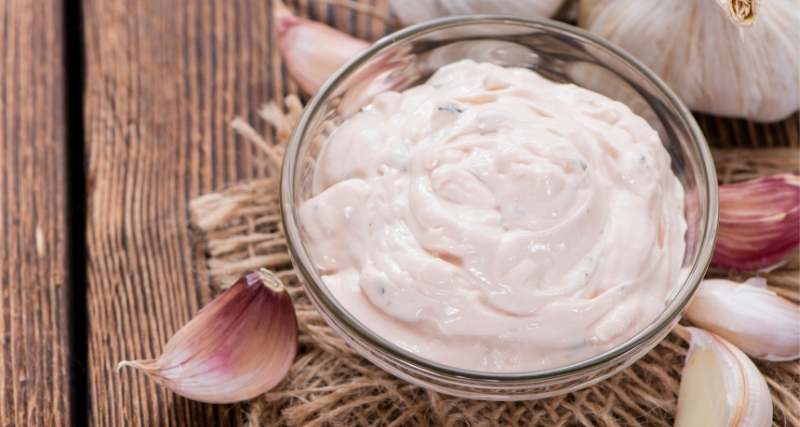
How do you say garlic in Spanish?
The Spanish word for garlic is “ajo.” If you are referring to a garlic clove, you say “diente de ajo,” and if you are talking about garlic bread, you say “pan de ajo.”
What is Alioli sauce made of?
Alioli sauce is traditionally made of just garlic and olive oil, some salt, and lemon juice. Nowadays, we add an egg yolk to the mixture so we can have an easier emulsion.
How to pronounce alioli?
To pronounce alioli, you say “a-yow-lee.”
What is truffle alioli?
Truffle Alioli is garlic mayonnaise but with an added flavor of truffle oil. Truffle is an exotic fungus that is similar to mushrooms. It is considered one of the modern ingredients of gastronomy today.
What is alioli sauce used for?
Alioli sauce is used as dips for many Spanish tapas, vegetable sticks, and grilled meats. It is also incorporated in pasta dishes to achieve a strong garlic flavor.
Spanish Garlic Alioli Recipe
Spanish Alioli Recipe – Homemade Garlic Mayonnaise
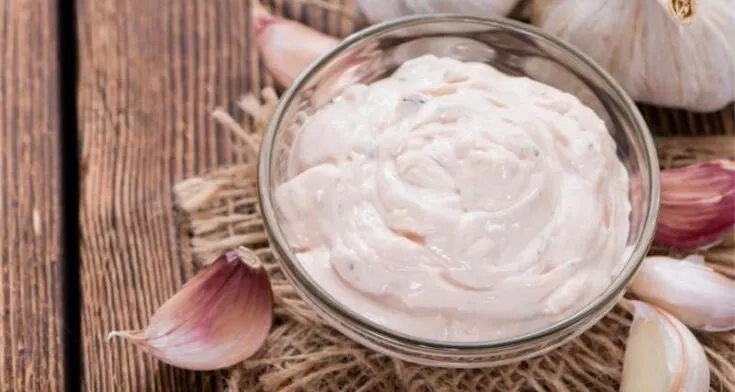
Ingredients
- 3-4 garlic cloves
- 2/3 – 3/4 cup of olive oil
- 1 egg yolk
- Salt to taste
- 1 teaspoon of natural lemon juice
Instructions
1. Prepare your garlic cloves by peeling and then mincing them.
2. Transfer all of the minced garlic into the mortar. Start pounding the garlic with the use of a pestle. Mash it well.
3. In a bowl, separate the egg yolk from the egg white. Set the egg white aside for another use. Take the egg yolk, add some salt to the bowl, and stir. Pour the yolk into the mortar with the mashed garlic.
4. Take oil and add some to the mortar in a slow stream. Take your time, continuously pounding in every addition and making sure you go in one direction the whole time. Pace yourself slowly so that the mixture will blend well.
5. Check if the mixture has thickened. If yes, add in the lemon juice to create a creamy, smooth, and delicious Spanish garlic alioli.
Nutrition Information:
Yield:
4Serving Size:
1Amount Per Serving: Calories: 696Total Fat: 78gSaturated Fat: 11gTrans Fat: 0gUnsaturated Fat: 65gCholesterol: 46mgSodium: 150mgCarbohydrates: 1gFiber: 0gSugar: 0gProtein: 1g
The nutritional information provided is approximate and can vary depending on several factors, so is not guaranteed to be accurate.
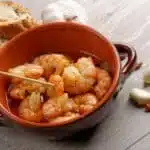

Leave a Reply